Economics Assignment: Economies of Scale, Elasticity, and Oligopoly
VerifiedAdded on 2019/11/25
|6
|1169
|183
Homework Assignment
AI Summary
This economics assignment examines several key economic concepts. It begins by defining economies of scale, explaining the advantages that accrue to a company through increased production, distinguishing between internal and external economies, and highlighting the long-run cost curve implications. The assignment then addresses income elasticity of demand, differentiating between normal, inferior, and luxury goods based on their elasticity values, and also discusses cross-price elasticity and its implications for complementary and substitute products. Finally, the assignment explores the kinked demand curve model of an oligopoly, explaining how firms in an oligopolistic market respond to price changes, using the auto industry as an example. The solution includes real-world examples and relevant formulas, supported by academic references.
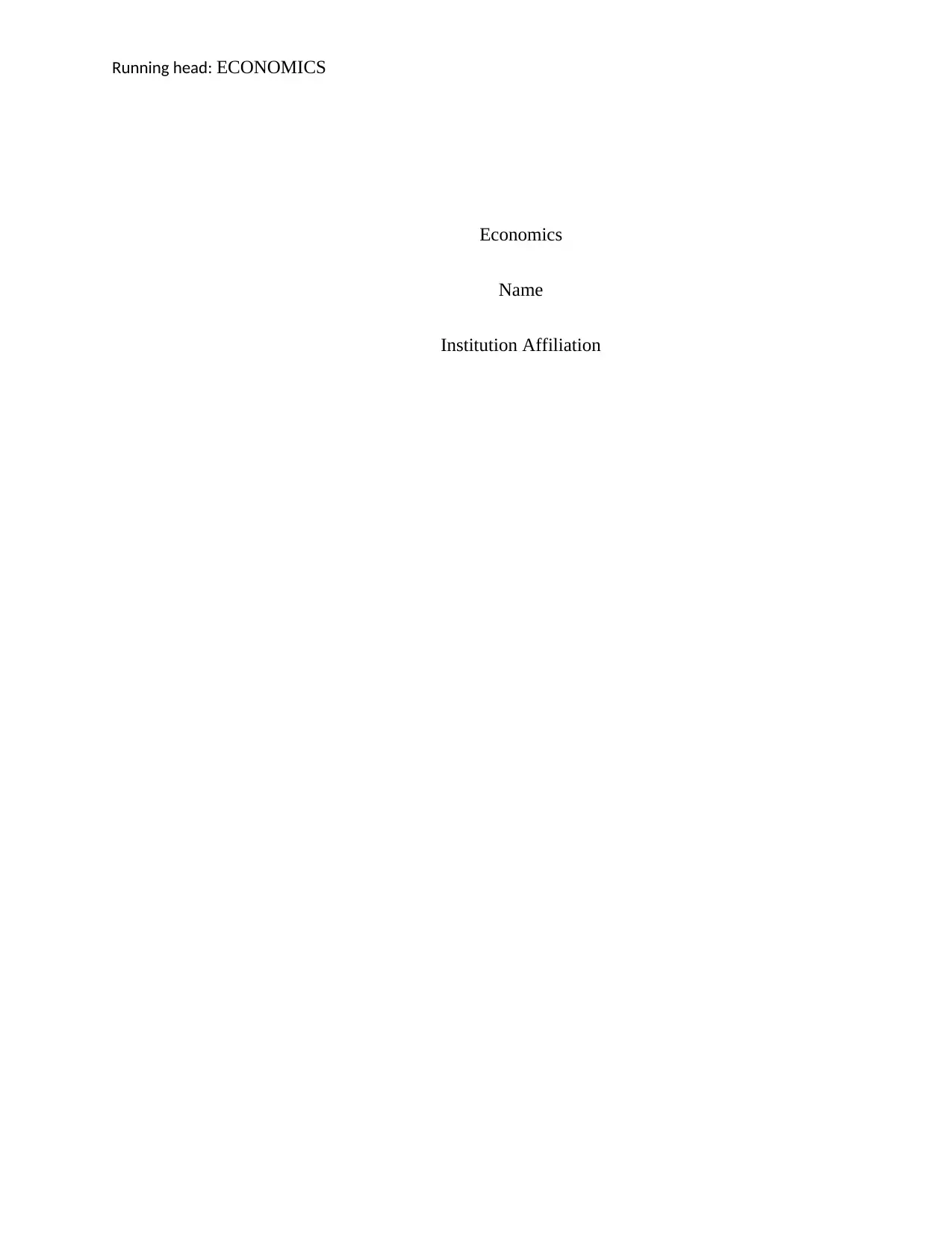
Running head: ECONOMICS
Economics
Name
Institution Affiliation
Economics
Name
Institution Affiliation
Paraphrase This Document
Need a fresh take? Get an instant paraphrase of this document with our AI Paraphraser
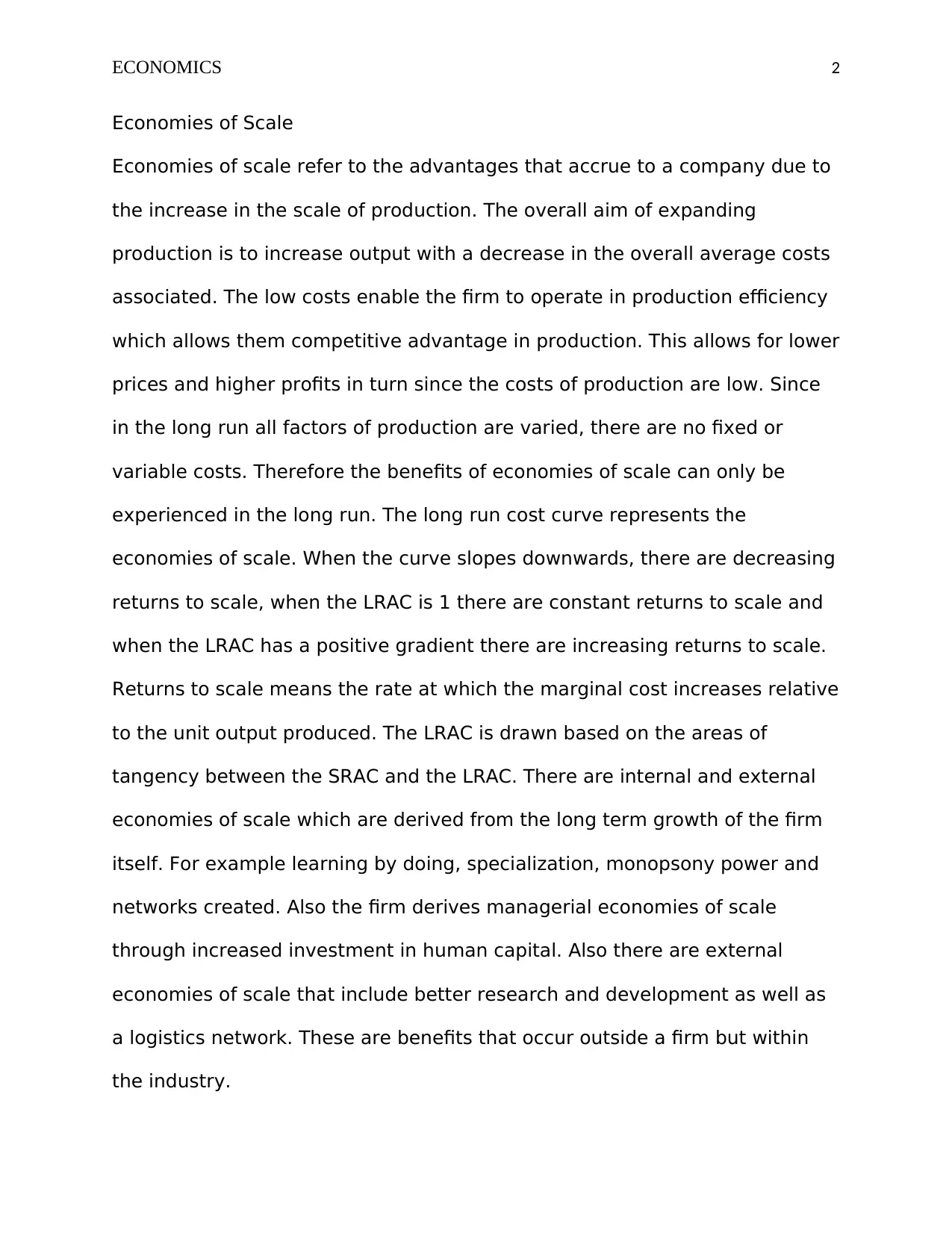
ECONOMICS 2
Economies of Scale
Economies of scale refer to the advantages that accrue to a company due to
the increase in the scale of production. The overall aim of expanding
production is to increase output with a decrease in the overall average costs
associated. The low costs enable the firm to operate in production efficiency
which allows them competitive advantage in production. This allows for lower
prices and higher profits in turn since the costs of production are low. Since
in the long run all factors of production are varied, there are no fixed or
variable costs. Therefore the benefits of economies of scale can only be
experienced in the long run. The long run cost curve represents the
economies of scale. When the curve slopes downwards, there are decreasing
returns to scale, when the LRAC is 1 there are constant returns to scale and
when the LRAC has a positive gradient there are increasing returns to scale.
Returns to scale means the rate at which the marginal cost increases relative
to the unit output produced. The LRAC is drawn based on the areas of
tangency between the SRAC and the LRAC. There are internal and external
economies of scale which are derived from the long term growth of the firm
itself. For example learning by doing, specialization, monopsony power and
networks created. Also the firm derives managerial economies of scale
through increased investment in human capital. Also there are external
economies of scale that include better research and development as well as
a logistics network. These are benefits that occur outside a firm but within
the industry.
Economies of Scale
Economies of scale refer to the advantages that accrue to a company due to
the increase in the scale of production. The overall aim of expanding
production is to increase output with a decrease in the overall average costs
associated. The low costs enable the firm to operate in production efficiency
which allows them competitive advantage in production. This allows for lower
prices and higher profits in turn since the costs of production are low. Since
in the long run all factors of production are varied, there are no fixed or
variable costs. Therefore the benefits of economies of scale can only be
experienced in the long run. The long run cost curve represents the
economies of scale. When the curve slopes downwards, there are decreasing
returns to scale, when the LRAC is 1 there are constant returns to scale and
when the LRAC has a positive gradient there are increasing returns to scale.
Returns to scale means the rate at which the marginal cost increases relative
to the unit output produced. The LRAC is drawn based on the areas of
tangency between the SRAC and the LRAC. There are internal and external
economies of scale which are derived from the long term growth of the firm
itself. For example learning by doing, specialization, monopsony power and
networks created. Also the firm derives managerial economies of scale
through increased investment in human capital. Also there are external
economies of scale that include better research and development as well as
a logistics network. These are benefits that occur outside a firm but within
the industry.
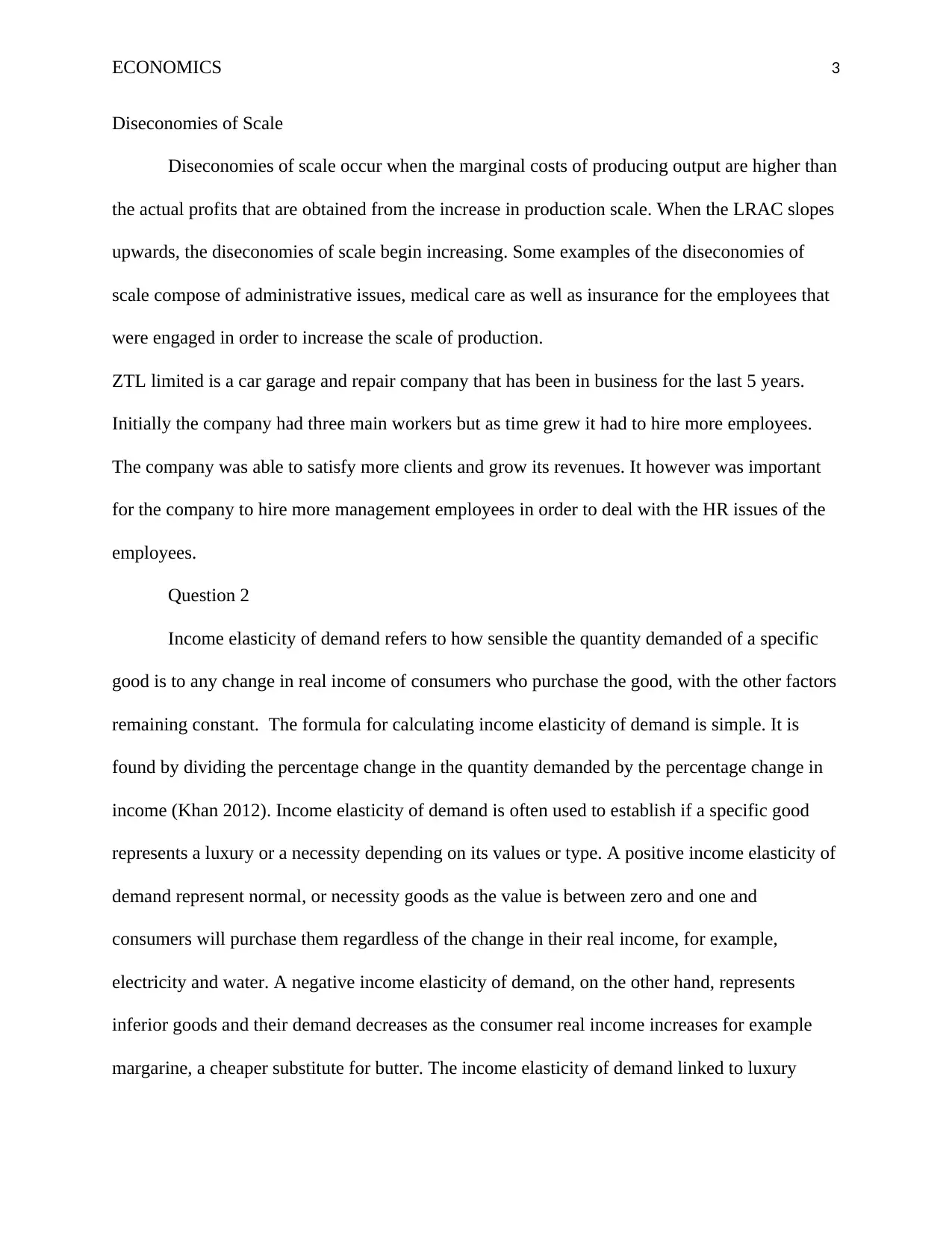
ECONOMICS 3
Diseconomies of Scale
Diseconomies of scale occur when the marginal costs of producing output are higher than
the actual profits that are obtained from the increase in production scale. When the LRAC slopes
upwards, the diseconomies of scale begin increasing. Some examples of the diseconomies of
scale compose of administrative issues, medical care as well as insurance for the employees that
were engaged in order to increase the scale of production.
ZTL limited is a car garage and repair company that has been in business for the last 5 years.
Initially the company had three main workers but as time grew it had to hire more employees.
The company was able to satisfy more clients and grow its revenues. It however was important
for the company to hire more management employees in order to deal with the HR issues of the
employees.
Question 2
Income elasticity of demand refers to how sensible the quantity demanded of a specific
good is to any change in real income of consumers who purchase the good, with the other factors
remaining constant. The formula for calculating income elasticity of demand is simple. It is
found by dividing the percentage change in the quantity demanded by the percentage change in
income (Khan 2012). Income elasticity of demand is often used to establish if a specific good
represents a luxury or a necessity depending on its values or type. A positive income elasticity of
demand represent normal, or necessity goods as the value is between zero and one and
consumers will purchase them regardless of the change in their real income, for example,
electricity and water. A negative income elasticity of demand, on the other hand, represents
inferior goods and their demand decreases as the consumer real income increases for example
margarine, a cheaper substitute for butter. The income elasticity of demand linked to luxury
Diseconomies of Scale
Diseconomies of scale occur when the marginal costs of producing output are higher than
the actual profits that are obtained from the increase in production scale. When the LRAC slopes
upwards, the diseconomies of scale begin increasing. Some examples of the diseconomies of
scale compose of administrative issues, medical care as well as insurance for the employees that
were engaged in order to increase the scale of production.
ZTL limited is a car garage and repair company that has been in business for the last 5 years.
Initially the company had three main workers but as time grew it had to hire more employees.
The company was able to satisfy more clients and grow its revenues. It however was important
for the company to hire more management employees in order to deal with the HR issues of the
employees.
Question 2
Income elasticity of demand refers to how sensible the quantity demanded of a specific
good is to any change in real income of consumers who purchase the good, with the other factors
remaining constant. The formula for calculating income elasticity of demand is simple. It is
found by dividing the percentage change in the quantity demanded by the percentage change in
income (Khan 2012). Income elasticity of demand is often used to establish if a specific good
represents a luxury or a necessity depending on its values or type. A positive income elasticity of
demand represent normal, or necessity goods as the value is between zero and one and
consumers will purchase them regardless of the change in their real income, for example,
electricity and water. A negative income elasticity of demand, on the other hand, represents
inferior goods and their demand decreases as the consumer real income increases for example
margarine, a cheaper substitute for butter. The income elasticity of demand linked to luxury
⊘ This is a preview!⊘
Do you want full access?
Subscribe today to unlock all pages.

Trusted by 1+ million students worldwide
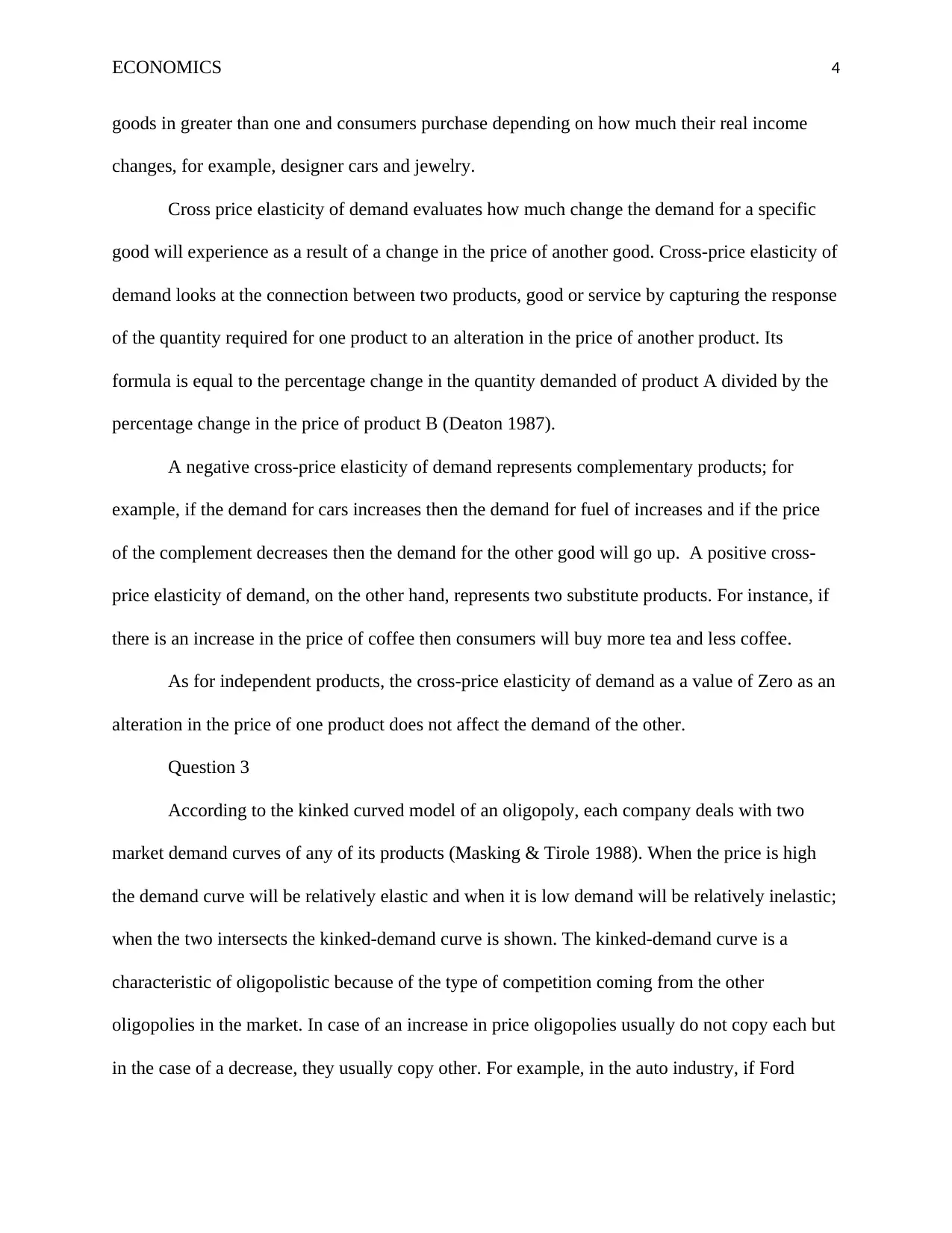
ECONOMICS 4
goods in greater than one and consumers purchase depending on how much their real income
changes, for example, designer cars and jewelry.
Cross price elasticity of demand evaluates how much change the demand for a specific
good will experience as a result of a change in the price of another good. Cross-price elasticity of
demand looks at the connection between two products, good or service by capturing the response
of the quantity required for one product to an alteration in the price of another product. Its
formula is equal to the percentage change in the quantity demanded of product A divided by the
percentage change in the price of product B (Deaton 1987).
A negative cross-price elasticity of demand represents complementary products; for
example, if the demand for cars increases then the demand for fuel of increases and if the price
of the complement decreases then the demand for the other good will go up. A positive cross-
price elasticity of demand, on the other hand, represents two substitute products. For instance, if
there is an increase in the price of coffee then consumers will buy more tea and less coffee.
As for independent products, the cross-price elasticity of demand as a value of Zero as an
alteration in the price of one product does not affect the demand of the other.
Question 3
According to the kinked curved model of an oligopoly, each company deals with two
market demand curves of any of its products (Masking & Tirole 1988). When the price is high
the demand curve will be relatively elastic and when it is low demand will be relatively inelastic;
when the two intersects the kinked‐demand curve is shown. The kinked-demand curve is a
characteristic of oligopolistic because of the type of competition coming from the other
oligopolies in the market. In case of an increase in price oligopolies usually do not copy each but
in the case of a decrease, they usually copy other. For example, in the auto industry, if Ford
goods in greater than one and consumers purchase depending on how much their real income
changes, for example, designer cars and jewelry.
Cross price elasticity of demand evaluates how much change the demand for a specific
good will experience as a result of a change in the price of another good. Cross-price elasticity of
demand looks at the connection between two products, good or service by capturing the response
of the quantity required for one product to an alteration in the price of another product. Its
formula is equal to the percentage change in the quantity demanded of product A divided by the
percentage change in the price of product B (Deaton 1987).
A negative cross-price elasticity of demand represents complementary products; for
example, if the demand for cars increases then the demand for fuel of increases and if the price
of the complement decreases then the demand for the other good will go up. A positive cross-
price elasticity of demand, on the other hand, represents two substitute products. For instance, if
there is an increase in the price of coffee then consumers will buy more tea and less coffee.
As for independent products, the cross-price elasticity of demand as a value of Zero as an
alteration in the price of one product does not affect the demand of the other.
Question 3
According to the kinked curved model of an oligopoly, each company deals with two
market demand curves of any of its products (Masking & Tirole 1988). When the price is high
the demand curve will be relatively elastic and when it is low demand will be relatively inelastic;
when the two intersects the kinked‐demand curve is shown. The kinked-demand curve is a
characteristic of oligopolistic because of the type of competition coming from the other
oligopolies in the market. In case of an increase in price oligopolies usually do not copy each but
in the case of a decrease, they usually copy other. For example, in the auto industry, if Ford
Paraphrase This Document
Need a fresh take? Get an instant paraphrase of this document with our AI Paraphraser
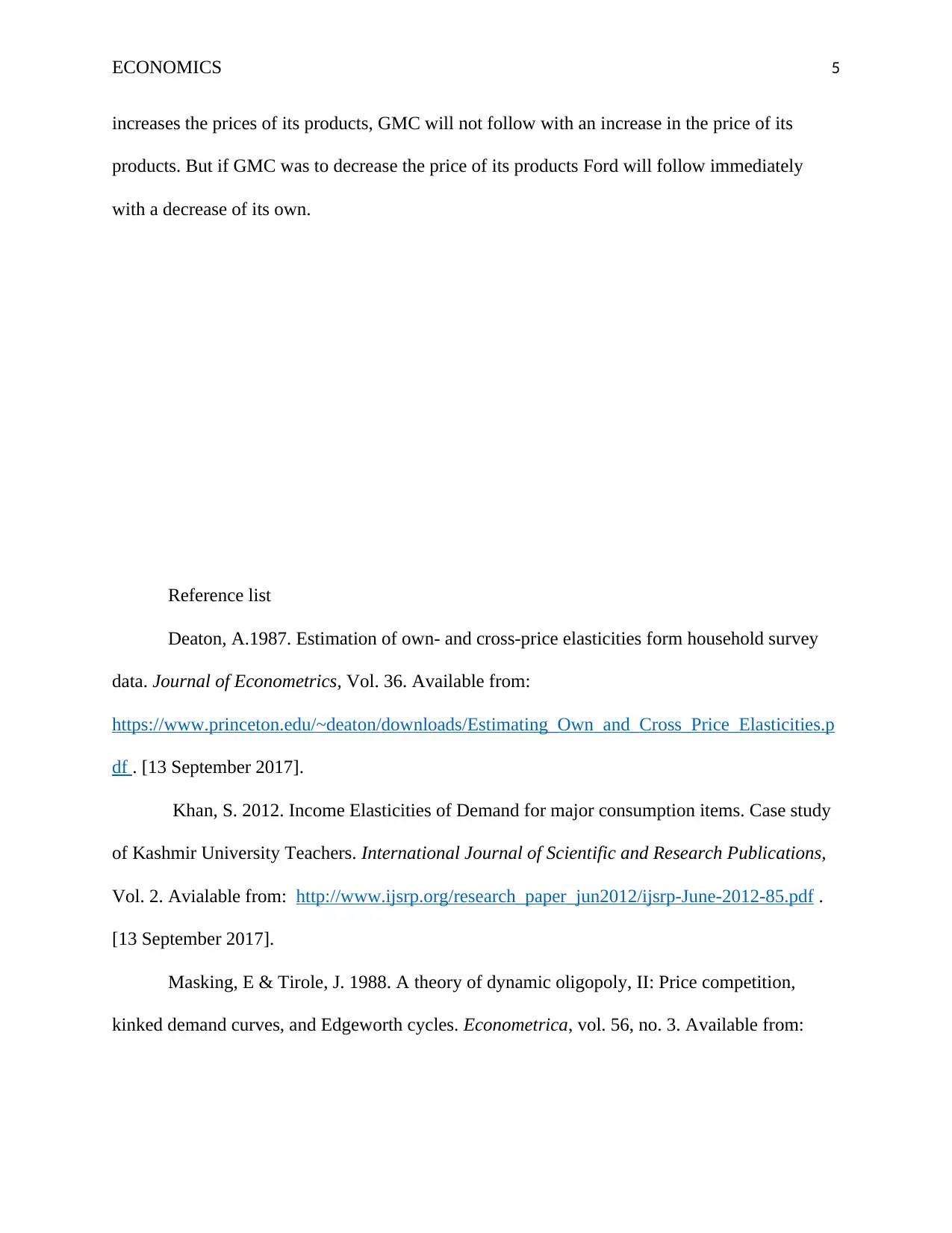
ECONOMICS 5
increases the prices of its products, GMC will not follow with an increase in the price of its
products. But if GMC was to decrease the price of its products Ford will follow immediately
with a decrease of its own.
Reference list
Deaton, A.1987. Estimation of own- and cross-price elasticities form household survey
data. Journal of Econometrics, Vol. 36. Available from:
https://www.princeton.edu/~deaton/downloads/Estimating_Own_and_Cross_Price_Elasticities.p
df . [13 September 2017].
Khan, S. 2012. Income Elasticities of Demand for major consumption items. Case study
of Kashmir University Teachers. International Journal of Scientific and Research Publications,
Vol. 2. Avialable from: http://www.ijsrp.org/research_paper_jun2012/ijsrp-June-2012-85.pdf .
[13 September 2017].
Masking, E & Tirole, J. 1988. A theory of dynamic oligopoly, II: Price competition,
kinked demand curves, and Edgeworth cycles. Econometrica, vol. 56, no. 3. Available from:
increases the prices of its products, GMC will not follow with an increase in the price of its
products. But if GMC was to decrease the price of its products Ford will follow immediately
with a decrease of its own.
Reference list
Deaton, A.1987. Estimation of own- and cross-price elasticities form household survey
data. Journal of Econometrics, Vol. 36. Available from:
https://www.princeton.edu/~deaton/downloads/Estimating_Own_and_Cross_Price_Elasticities.p
df . [13 September 2017].
Khan, S. 2012. Income Elasticities of Demand for major consumption items. Case study
of Kashmir University Teachers. International Journal of Scientific and Research Publications,
Vol. 2. Avialable from: http://www.ijsrp.org/research_paper_jun2012/ijsrp-June-2012-85.pdf .
[13 September 2017].
Masking, E & Tirole, J. 1988. A theory of dynamic oligopoly, II: Price competition,
kinked demand curves, and Edgeworth cycles. Econometrica, vol. 56, no. 3. Available from:
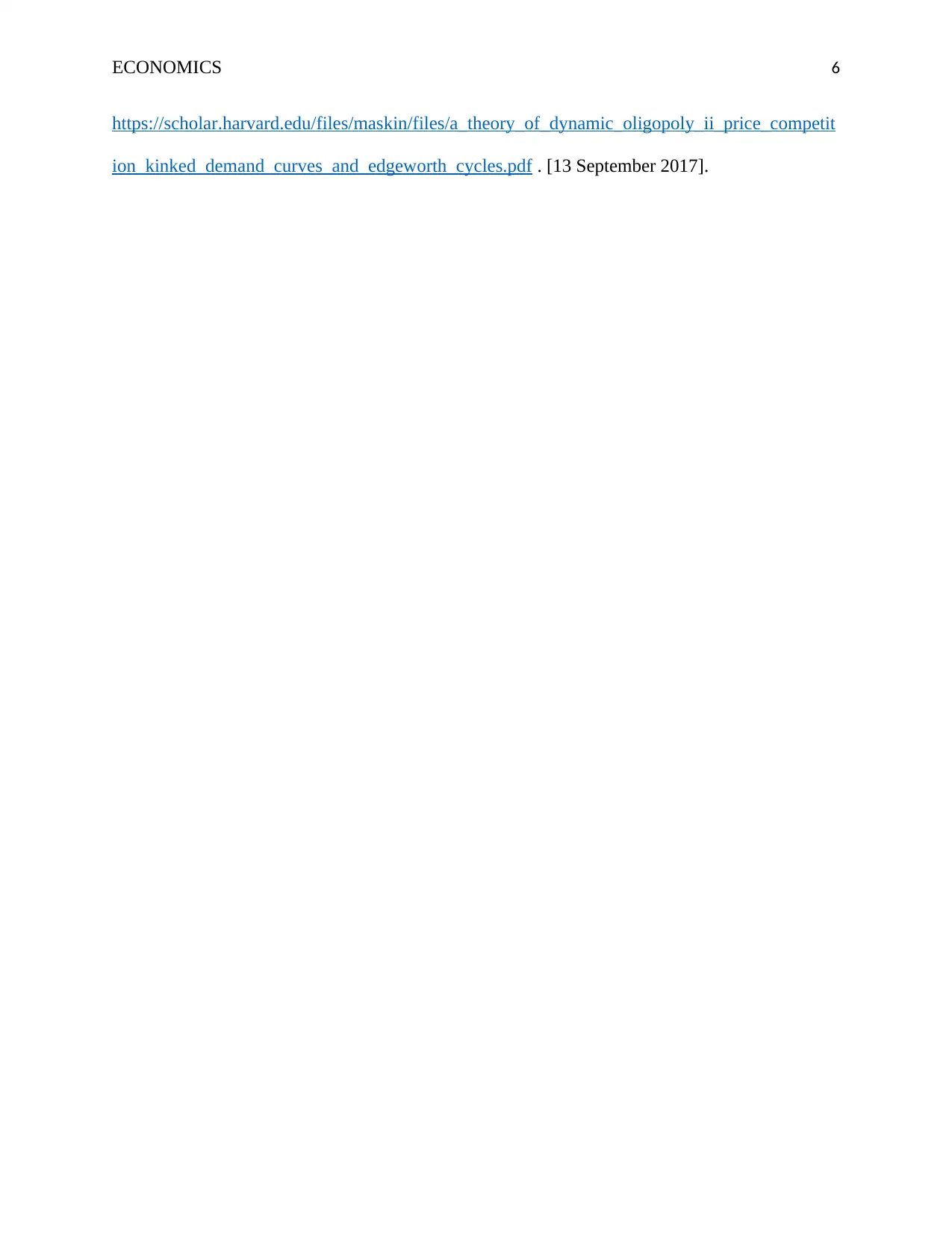
ECONOMICS 6
https://scholar.harvard.edu/files/maskin/files/a_theory_of_dynamic_oligopoly_ii_price_competit
ion_kinked_demand_curves_and_edgeworth_cycles.pdf . [13 September 2017].
https://scholar.harvard.edu/files/maskin/files/a_theory_of_dynamic_oligopoly_ii_price_competit
ion_kinked_demand_curves_and_edgeworth_cycles.pdf . [13 September 2017].
⊘ This is a preview!⊘
Do you want full access?
Subscribe today to unlock all pages.

Trusted by 1+ million students worldwide
1 out of 6
Related Documents
Your All-in-One AI-Powered Toolkit for Academic Success.
+13062052269
info@desklib.com
Available 24*7 on WhatsApp / Email
![[object Object]](/_next/static/media/star-bottom.7253800d.svg)
Unlock your academic potential
Copyright © 2020–2025 A2Z Services. All Rights Reserved. Developed and managed by ZUCOL.



